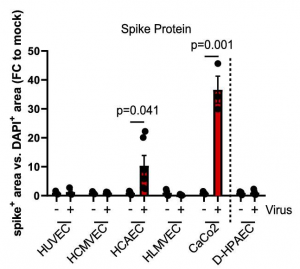A group from Goethe University Frankfurt, Germany, etc. has reported on infection susceptibility of various human endothelial cells by SARS-CoV-2.
https://www.ncbi.nlm.nih.gov/pmc/articles/PMC8256413/
SARS-CoV-2 primarily invades alveolar epithelial cells and causes acute respiratory distress syndrome (ARDS). However, increasing evidence indicates that endothelial cell dysfunction and vascular events are major complications of the disease. Indeed, vascular inflammation, barrier defects leading to tissue edema, activation of disseminated intravascular coagulation and microthrombi were reported in moderate to severe COVID-19 cases. However, it is still unclear whether the endothelial dysfunction is caused by direct infection of endothelial cells or is mainly secondary caused by inflammation cascade due to cytokine release.
Various human endothelial cells from different vascular beds were incubated with SARS-CoV-2 to investigate infection susceptibility of SARS-CoV-2 to those endothelial cells. Evaluated cells are as follows;
Human umbilical vein endothelial cells (HUVEC),
human coronary artery endothelial cells (HCAEC),
human cardiac microvascular endothelial cells (HCMVEC), and
human lung microvascular endothelial cells (HLMVEC).
SARS-CoV-2 spike protein was only detected in HCAECs after the virus infection but not in the other endothelial cells tested. This is consistent with the fact the only HCAEC expressed the SARS-CoV-2 receptor angiotensin-converting enzyme 2 (ACE2) which is required for virus infection.
Human colon carcinoma cells (CaCo2) were used as positive control of the SARS-CoV-2 infection,

Although the spike protein was detected in HCAECs after SARS-CoV-2 infection, this does not necessarily mean infection of the endothelial cells. Therefore, the levels of double-stranded RNA, as a sign of viral RNA multiplication, and the presence of infectious virus in the cell supernatant, which would be indicative of viral replication, were evaluated further. However, neither double-strand RNA nor infectious virus in HCAEC supernatant could be detected 5 days after SARS-CoV-2 infection, suggesting that no new virus is generated by the tested endothelial cells and that the spike protein may originated from the virus that was originally taken up.
In conclusion, the massive endothelial dysfunction and microvascular thrombotic complications observed in patients suffering from COVID-19 is mainly secondarily caused by the inflammatory cascades mediated by the cytokine release syndrome.
